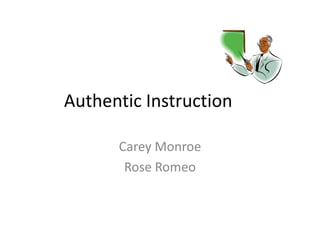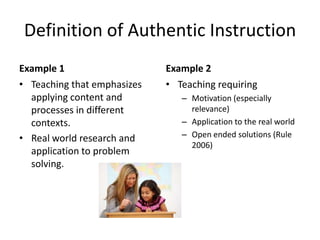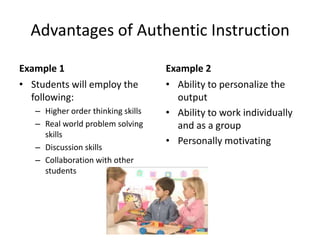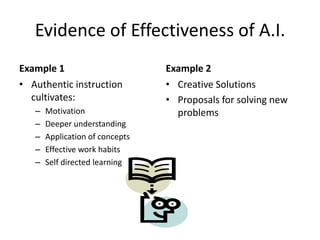Authentic Instruction
- 1. Authentic Instruction Carey Monroe Rose Romeo
- 2. Sample Assignment Example 1 Example 2 âĒ Students will research âĒ New Employee will join a successful businesses in the team in a globally U.S. and abroad established company âĒ Students will compile a list âĒ Employee will reach out to of 10 Rules to a successful multiple roles to consolidate business according to their information required by research findings. business group âĒ Students will present these âĒ Employee will post in findings to their peers using electronic reading room to a preferred web 2.0 tool. key stakeholders
- 3. Definition of Authentic Instruction Example 1 Example 2 âĒ Teaching that emphasizes âĒ Teaching requiring applying content and â Motivation (especially processes in different relevance) contexts. â Application to the real world âĒ Real world research and â Open ended solutions (Rule 2006) application to problem solving.
- 4. Advantages of Authentic Instruction Example 1 Example 2 âĒ Students will employ the âĒ Ability to personalize the following: output â Higher order thinking skills âĒ Ability to work individually â Real world problem solving and as a group skills âĒ Personally motivating â Discussion skills â Collaboration with other students
- 5. Limitations of Authentic Instruction Example 1 Example 2 âĒ More planning time is âĒ Teachers (bosses must be required by teachers. sensitive to waning âĒ More preparation time for motivation materials. âĒ Students must have a level âĒ Implementation will take of maturity to appreciate longer for most value of bi directional assignments. problem-solving
- 6. Role of the Teacher Example 1 Example 2 âĒ Coach and model for âĒ Able to provide constructive students feedback and remain a âĒ Provide guiding questions motivator for research âĒ Promote reflection and âĒ Provide valuable feedback brainstorming for solutions âĒ Include all students in the âĒ Promote teamwork process âĒ Give examples that draw on previous knowledge and experience of students
- 7. Role of the Students Carey Rose âĒ Research âĒ Analyze and Evaluate âĒ Analyze data âĒ Self reflection âĒ Problem solving, decision âĒ Working towards self- making improvement âĒ Communicating results âĒ Creating presentations âĒ Demonstrating findings
- 8. Authentic Assessments Example 1 Example 2 âĒ Peer assessments and âĒ Productive/Effective Peer reviews Review âĒ Project rubrics âĒ Implementation of all 4 âĒ Informal observations levels of the Kirkpatrick âĒ Application of results to Model similar problem (Reaction, Learning, Behavi or, Results) (Kirkpatrick, p.21) (Kirkpatrick, 2006)
- 9. Digital Tools for Authentic Instruction Example 1 Example 2 âĒ Computers with internet âĒ Computers access âĒ Tablets âĒ Blogs âĒ Phones âĒ Podcasts âĒ Apps (both internal and âĒ Forums external to company) âĒ Wiki spaces
- 10. Evidence of Effectiveness of A.I. Example 1 Example 2 âĒ Authentic instruction âĒ Creative Solutions cultivates: âĒ Proposals for solving new â Motivation problems â Deeper understanding â Application of concepts â Effective work habits â Self directed learning
- 11. Supplemental Reading List Example 1 Example 2 âĒ Educational Leadership âĒ Lombardi, MM (2007) Authentic Learning for the 21st Century: An Journal Overview, Retrieved from http://net.educause.edu/ir/librar âĒ Related Journal Articles: y/pdf/ELI3009.pdf on March â The effect of web 2.0 on 5, 2013 Teaching and Learning âĒ Hilt, L (2011) What do we mean â Authentic instruction for 21st by authentic learning? Retrieved century learning from: â Overcoming obstacles using http://plpnetwork.com/2011/04/ 21/what-do-we-mean-by- authentic instruction: a authentic-learning/ on March comparative case study. 5, 2013
- 12. References âĒ Newmann, F., & Wehlage, G. (1993). Authentic learning. Educational Leadership, 50(7), 8-12. Retrieved from http://www.ascd.org/publications/educational- leadership/apr93/vol50/num07/Five-Standards-of-Authentic- Instruction.aspx âĒ Byrne, R. (2009). The Effect of Web 2.0 on Teaching and Learning. Teacher Librarian, 37(2), 50-53. âĒ Preus, B. (2012). Authentic Instruction for 21st Century Learning: Higher Order Thinking in an Inclusive School. American Secondary Education, 40(3), 59-79. âĒ Rule, AC (2006) Editorial: The Components of Authentic Learning, Journal of Authentic Learning 3(1): 1-10. âĒ Kirkpatrick, DL and JD Kirkpatrick (2006) Evaluating Training Programs: The Four Levels, 3rd Edition, Berrett-Koehler, San Francisco












